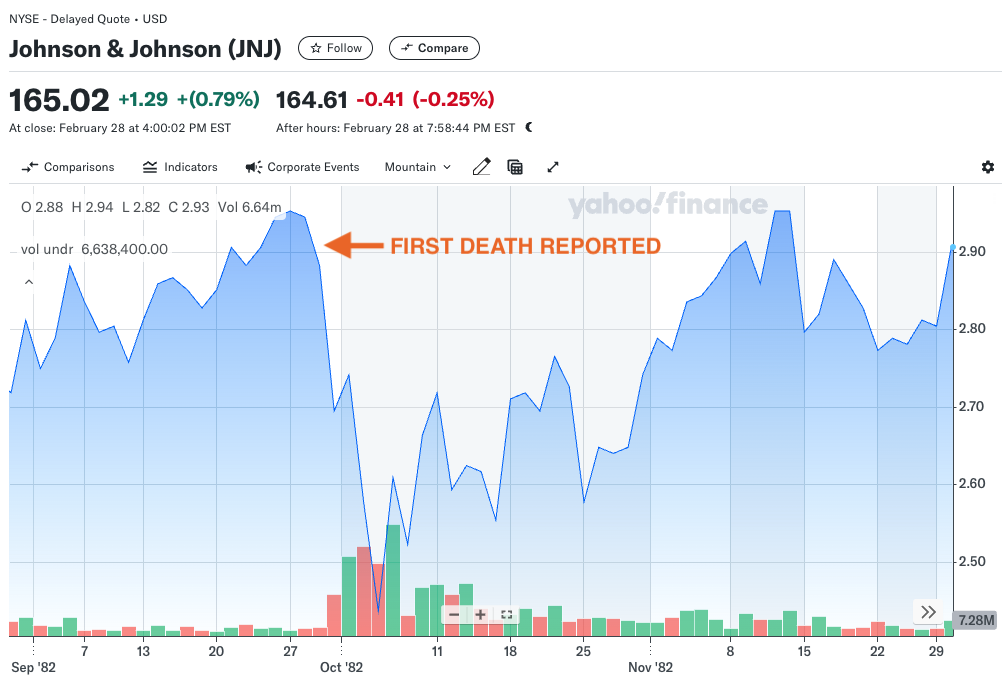The Crisis That Changed Everything: How the Tylenol Poisoning Case Reshaped Corporate Crisis Management

On the morning of Sept. 29, 1982, in a quiet Chicago suburb, a 12-year-old girl named Mary Kellerman woke up with a sore throat. Her parents gave her a capsule of Extra-Strength Tylenol, the same over-the-counter pain reliever found in nearly every American household. A few hours later, she was dead.
That same day, 27-year-old Adam Janus, a postal worker, took Tylenol for what he thought was a routine headache. He collapsed and died shortly after.
By the end of the week, seven people across the Chicago area had been poisoned, all after consuming Tylenol capsules laced with potassium cyanide. Panic swept through the city, then the country. What had once been the most trusted painkiller in America was now an object of terror. The question wasn’t just who had done this—it was whether Johnson & Johnson, the pharmaceutical giant behind Tylenol, could survive at all.
A Company on the Brink
In 1982, Johnson & Johnson was not just another corporation. It was a paragon of consumer trust, a company that had built its reputation on the belief that its products were safe, reliable and essential. Tylenol alone accounted for nearly 37 per cent of the company’s painkiller market share, making it one of the most dominant household brands of its time.
So when the deaths were traced back to Tylenol bottles that had been tampered with, it wasn’t just a public health crisis—it was an existential threat. Competitors saw an opportunity. The media seized the moment with grim fascination, running headlines that blurred the line between breaking news and mass hysteria.
This was before the 24-hour news cycle, before social media, before brands could issue a carefully worded tweet in response to disaster. Johnson & Johnson had one shot to get this right.
And unlike many corporations that have floundered in moments of crisis, they did.
The Tylenol Playbook
At first, the FBI suspected a mad scientist, a disgruntled employee or even an act of corporate sabotage. But soon, investigators realized the poisonings weren’t coming from inside Johnson & Johnson’s manufacturing plants. Someone had likely purchased bottles, laced the capsules with cyanide and then placed them back on store shelves.
That revelation gave Johnson & Johnson a legal out. They could have distanced themselves from the crisis, blamed a lone criminal and insisted their production lines were safe.
Instead, they did something unprecedented:
- The company immediately recalled 31 million bottles of Tylenol, a move that cost them over $100 million.
- They issued direct warnings to consumers via national television, urging them to stop using Tylenol until further notice.
- They cooperated fully with the media, offering daily updates instead of hiding behind legal statements.
- They reintroduced Tylenol months later with a new triple-seal tamper-proof bottle, setting the gold standard for safety in consumer products.
At a time when corporate PR often meant issuing vague, defensive statements, Johnson & Johnson took radical responsibility—and in doing so, saved their brand.
By the following year, Tylenol’s market share had rebounded to 30 per cent, proving that transparency and decisive action could rebuild consumer trust.

But that was 1982. Today, crises move faster. The difference between rebuilding a reputation and watching it collapse comes down to how quickly, and how consistently, an organization controls its messaging.
The Speed of Crisis Has Changed—The Fundamentals Have Not
If the Tylenol poisonings happened today, the crisis would play out in minutes, not days. A single viral video of a distraught family member could turn public sentiment against the company before they even had a chance to respond.
News cycles no longer reset overnight—they evolve in real time, shaped by a relentless flood of media inquiries, social speculation and digital outrage.
The fundamentals of crisis communications haven’t changed. Companies that respond quickly and transparently can weather the storm. The challenge now is that every crisis comes with an overwhelming volume of incoming media inquiries, fragmented messaging across multiple platforms and a need for absolute internal coordination.
For every public statement, there are countless internal conversations happening behind the scenes.
Journalists flood inboxes with urgent media inquiries.
Executives demand real-time briefings.
PR teams scramble to align messaging across different departments.
Even companies with the best instincts can struggle to coordinate a response when information is scattered, media inquiries are piling up and every second counts.
This is where crisis-response technology has become an essential part of modern communications strategy.
The Invisible Work of Crisis Management
Behind every successful corporate crisis response, there’s a level of organization and coordination that rarely gets public attention. The ability to ensure that every journalist inquiry is tracked, every executive statement is aligned and every department is working with the same information is often what determines whether a company successfully manages a crisis—or fuels it.
That’s where tools like Broadsight Tracker come in.
Broadsight Tracker isn’t about automating crisis management. It’s about ensuring that when a crisis hits, communication teams aren’t reacting blindly—they’re operating with clarity.
- Every journalist request is logged and tracked.
- Every executive response is aligned with the broader strategy.
- Every update is recorded in one place, ensuring no miscommunication.
At a time when crises unfold at unrelenting speed, PR and communication teams don’t just need good instincts. They need structure.
If the Tylenol crisis had unfolded in today’s media landscape, Johnson & Johnson’s approach would have remained the same: transparency, responsibility and decisive action.
But the speed of their response? That would have required something else entirely.
Final Thoughts
The Tylenol poisonings remain the ultimate PR case study, not because Johnson & Johnson had the perfect response plan, but because they understood the fundamental truth of crisis communications:
You don’t control when a crisis hits. You only control how prepared you are when it does.
And in a world where PR crises unfold at the speed of social media, the ability to log, track and coordinate response strategies in real time is what separates the brands that survive from the brands that disappear.
Want to save time, reduce stress and stay ahead of the story? Broadsight Tracker simplifies media inquiry management, streamlines response coordination and keeps your messaging consistent—so your team can focus on strategy instead of scrambling for information. See how it makes external communications effortless at broadsighttracker.ca.
Receive our newsletter
Sign up below and we’ll be in touch with monthly updates about Broadsight Tracker, along with news and insights to keep you on the cutting edge of communications work in an AI era.